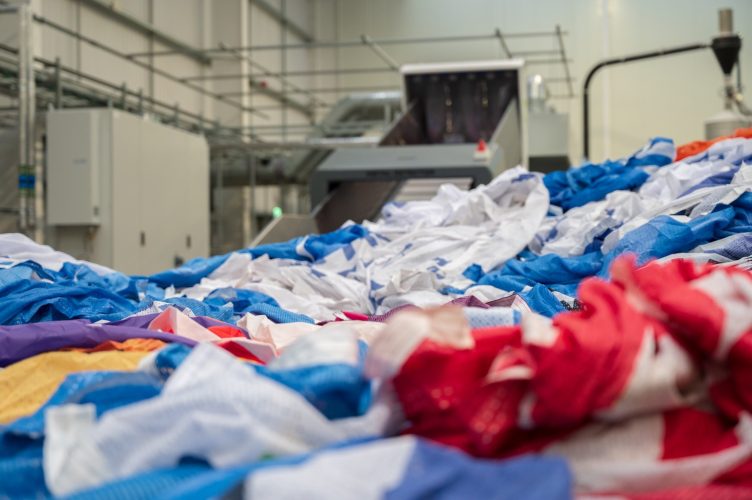TriplePundit • Is a Circular Polyester Boom Around the Corner?

It’s no secret that the global economy has a textile waste problem. Overproduction and overconsumption are choking the planet with carbon dioxide and burying it in barely worn fast fashion. Textile circularity, although long overdue, is finally gaining traction thanks to Extended Producer Responsibility legislation in the European Union. With the deadline for producers to take responsibility for collecting and recycling the textiles they sell in the EU looming, a United Kingdom-based polyester recycler is ready to make circularity a reality.
A waste problem that doesn’t have to be
An entire garbage truck’s worth of textiles is disposed of every second, according to the United Nations Environment Program. Most of the more than 100 million metric tons of fibers produced each year for things like apparel, home textiles, and footwear will be discarded. Roughly 87 percent of textiles end up in landfills or incinerators each year, according to a report from the European Union. A hefty chunk is also sent to developing countries, where massive heaps of fast fashion swallow up the landscape and litter coastlines.
According to a widely cited 2017 report, a mere 1 percent of clothing is recycled. But just because it isn’t recycled, doesn’t mean it can’t be.
“We reckon that about 30 percent of all clothing, whether it’s made from cotton, polyester, nylon, or wool, or whatever, is already recyclable,” Tim Cross, founder and CEO at the U.K. not-for-profit Circular Textiles Foundation and polyester recycler Project Plan B, told TriplePundit. “But it isn’t being recycled because neither the recycler nor the designer or the garment seller knows that it’s recyclable.”
An additional one-third of clothing could be recycled with minor design changes like switching out buttons and labels for uniform material that doesn’t affect the form, function or cost of the clothing, he said. With such alterations, nearly two-thirds of clothing could be recycled.
“Extended Producer Responsibility legislation requires recyclable design … and big brands are realizing this is going to be very important,” Cross said. “We are seeing considerable improvements in the way the big brands are looking at circular design.”
The Circular Textiles Foundation helps manufacturers build recyclability into their garments by working with them to produce 100 percent polyester clothing — avoiding blended materials as well as tags and buttons made from other things.
“That’s what we have changed,” Cross said. “Everyone else seems to be taking the view that you need to go for chemical depolymerization of polyester, that that’s the only solution. And it’s nonsense. You don’t need to do that at all.”
Keeping polyester recycling simple
The polyester recycling company Cross founded, Project Plan B, is focused on what happens at the end of garments life, rather than the beginning. It relies on a straightforward process that uses heat and pressure to melt polyester fabric down and push it through filters that turn it into pellets, Cross said. Those pellets are spun into yarn that can be used to produce new clothing. The process, called thermo-mechanical extrusion, is basically the same technology used for recycling plastic, just at a different temperature.
“The biggest advantage is that it’s simple,” Cross said. “You don’t need to be a scientist to run one of these machines.”
While pellets made from colored textiles are not 100 percent pure polyester, they can still be used to spin a high-quality yarn for making black garments, which have no shortage of demand, Cross said. Pellets made from white polyester fabric, on the other hand, are spun into yarn that is the same quality as brand-new, virgin polyester.
In addition to keeping textiles out of landfills, Project Plan B’s methods produce 89 percent less carbon dioxide than manufacturing virgin polyester, Cross said.
A recycling partnership with Salvation Army
In early 2024, Project Plan B partnered with Salvation Army in the U.K. to form Project Re:claim, a commercial-scale, post-consumer polyester recycling plant. In the past 18 months, the recycler processed over 1,000 metric tons of unsellable donations the charity would have otherwise disposed of. Each metric ton is made up of 3,000 to 4,000 garments, Cross said.
“The Salvation Army has been a perfect partner for us, because they have a big textile waste problem, and they understand it better than most people,” he said, noting the organization handles 80,000 metric tons of textiles in the U.K. each year.
For now, Project Re:claim only processes items the Salvation Army can identify as 100 percent polyester. As recycled material is used to make clothing that is designed for recycling, the range of what can be recycled will increase, Cross said. He expects it to be about five years before those garments begin to make their way into the recycling system.
From challenges to change
Project Plan B’s biggest challenge is not making high-quality polyester pellets, Cross said. It’s getting clothing manufacturers to buy them. Since manufacturers are purchasing through an entirely different supply chain, a shift in mindset is needed to make it happen.
Still, some brands are working with these organizations on the forefront of change. The Guardian previously named the school uniform brand David Luke and the retailers John Lewis and Tesco as a few.
A surge in brand interest for recycled polyester seems likely once minimum recycled content requirements, which will be set by the forthcoming EU Strategy for Sustainable and Circular Textiles, are in place. Since the changes brands make to meet regulations in Europe tend to spill over to the other markets, global demand could increase, as well.
“I think the most important thing to get across to people is that change is coming, it’s coming quickly, and garment manufacturers and brands want this as much as anybody else,” Cross said. “What they really want is a level playing field, so they want Extended Producer Responsibility legislation to be enforced and to be effective.”



Post Comment